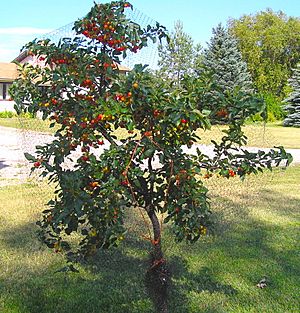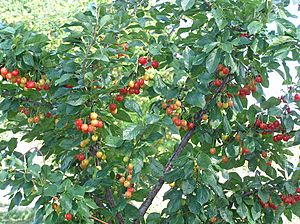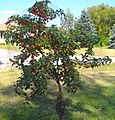Evans Cherry facts for kids
Quick facts for kids Evans Cherry |
|
|---|---|

A young Evans Cherry tree growing in Montana, with ripening cherries
|
|
| Genus | Prunus |
| Species | P. cerasus |
| Cultivar | 'Evans', also known as 'Bali' |
| Origin | Alberta, Canada, 1923 or earlier |
The Evans Cherry, also called 'Bali', is a special kind of sour cherry tree. It was found again in an old orchard near Edmonton, Alberta, Canada. This cherry tree is very important because people thought cherries could not grow well in the cold Canadian prairies. However, this specific tree, found by Ieuan Evans, had been growing there since the 1920s!
The Evans Cherry tree grows on its own roots and can pollinate itself. This means it doesn't need another tree to help it make fruit. In spring, it has beautiful white flowers, and later it grows lots of tasty cherries.
Contents
What Makes the Evans Cherry Special?
The Evans Cherry tree usually grows to be about 12 to 14 feet (3.6 to 4.2 meters) tall. Other sour cherry trees are often taller. In the spring, this tree is covered in many white blossoms.
Its bright red fruits weigh about 0.15 ounces (4.4 grams) each. The juice from these cherries is usually pink or clear.
Growing the Evans Cherry Tree
A great thing about the Evans Cherry is that it can grow on its own rootstock. This means you don't need to graft it onto another tree's roots. Grafting is when you join parts of two plants together. Sometimes, when you graft, the top part (the shoot) and the root part don't get along, or the connection isn't strong. This can cause problems as the tree grows. Since the Evans Cherry grows on its own roots, these problems are avoided.
It's best to train the Evans Cherry to grow like a tree, not a bush. This makes it much easier to pick the fruit when it's ready. This cherry tree can pollinate itself, meaning it doesn't need another cherry tree nearby to make fruit. It grows well in cold areas, even in Zone 3a climates. In North America, the cherries are usually ready to pick in August.
The Story of the Evans Cherry
Ieuan Evans, who is a plant expert called a horticulturist, found out about a gardener named "Mrs. Bower." She lived northeast of Edmonton, near Fort Saskatchewan. Mrs. Bower had been growing cherry trees since 1923, and they produced lots of fruit!
Her orchard was going to be removed to build a new jail. So, Mrs. Bower invited Ieuan Evans to take some of her cherry trees. He took some for the Alberta Tree Nursery and some for himself.
How the Cherry Spread
Ieuan Evans discovered that small shoots, called suckers, that grew from the cherry trees' roots were easy to grow into new trees. He shared these suckers with many friends and people he knew. Everyone who grew these new trees was very happy with how strong they were and how good the fruit tasted.
At first, many nurseries didn't want to sell the Evans Cherry tree. They believed that cherries couldn't grow well in the Canadian prairies, even though Mrs. Bower's trees proved them wrong! But eventually, nurseries like DNA Gardens near Red Deer, Alberta started growing and selling the trees. Later, a nursery in Winnipeg, Manitoba, began selling thousands of these trees. Today, they sell out every year!
The Evans Cherry tree is now in the public domain. This means anyone can grow and sell it without special permission. It has been sold as cuttings (small pieces of the plant that can grow roots) and also grown using Plant tissue culture (growing plants from tiny pieces in a lab) in parts of Canada and the United States.
Images for kids




